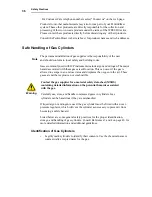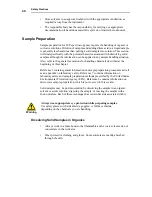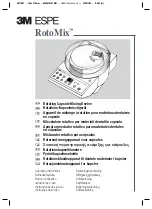
Preparing Your Laboratory
50
Exhaust Vent Requirements
The Optima 8000 requires an exhaust vent to remove combustion fumes and vapors
from the torch compartment. Exhaust venting is important for the following reasons:
•
It protects laboratory personnel from toxic vapors that may be produced by some
samples.
•
It improves the stability of the ICP torch by removing the effects of room drafts
and laboratory atmosphere.
•
It helps to protect the instrument from corrosive vapors that may originate from
the sample(s).
•
It removes dissipated heat produced from the torch and power supply.
The maximum temperature for the ICP torch vent system is 200 °C (392
F). To
withstand these temperatures, stainless-steel must be used.
ICP torch vent required minimum flow rate is 5600 liters/min (200 cubic feet/min)
at the end of the venting hood.
The blower capacity depends on the duct length and number of elbows or bends used
to install the system. If an excessively long duct system or a system with many bends
is used, a stronger blower may be necessary to provide sufficient exhaust volume.
Alternatively, smooth stainless-steel may be used instead of flexible stainless-steel
where flexibility is not required to reduce system friction loss or “drag.” If smooth
stainless steel is used, there must be a way to move the vent hood out of the way for
servicing. A length of smooth stainless-steel ducting has 20-30% less friction loss
Warning: Toxic fumes
The use of ICP-OES instruments without adequate ventilation to outside air may
constitute a health hazard. For example, the combustion of halogenated
hydrocarbons produces toxic vapors. Extreme care should be taken that exhaust
gases are vented properly.
Note
Local electrical codes do not allow PerkinElmer Service Engineers to install the
blower and vent assembly.
!
Warning
Summary of Contents for OPTIMA 8000
Page 1: ...OPTIMA 8000 Customer Hardware and Service Guide ICP OPTICAL EMISSION Return to Document Menu...
Page 2: ......
Page 3: ...Optima 8000 Customer Hardware and Service Manual...
Page 12: ...Contents 10...
Page 18: ...16 Indicates the ON position of the main power switch Indicates alternating current...
Page 24: ...22 Figure C Location of warning labels in the sample compartment 1 2...
Page 28: ...26...
Page 29: ...Safety Practices 1...
Page 49: ...Preparing Your Laboratory 2...
Page 61: ...Preparing Your Laboratory 60...
Page 62: ...System Description 3...
Page 89: ...Installation 4...
Page 136: ...Maintenance 5...
Page 241: ...Troubleshooting 6...
Page 264: ...Error Messages 7...
Page 284: ......
















































